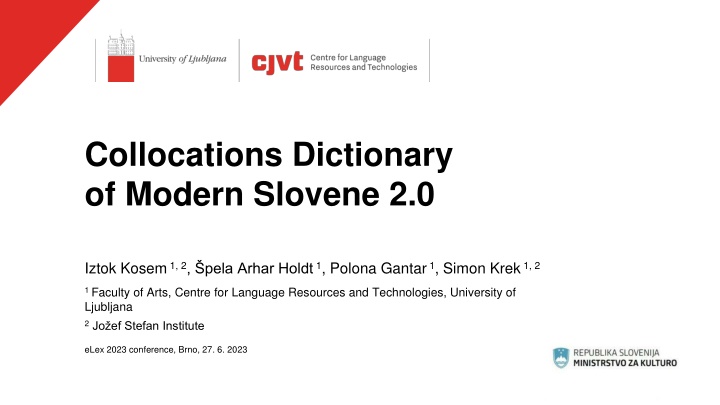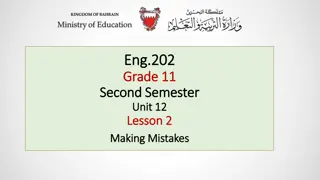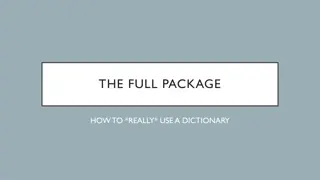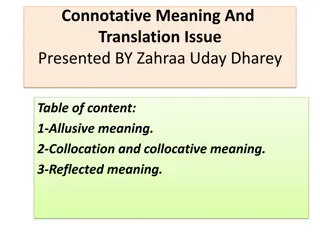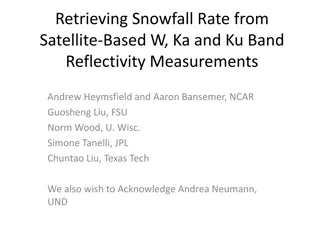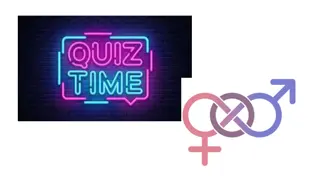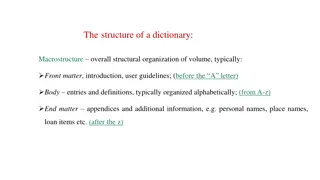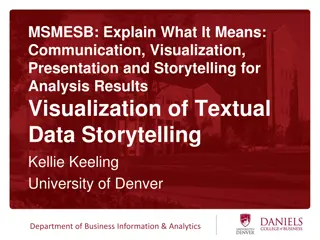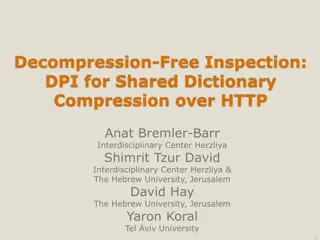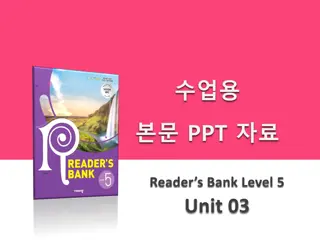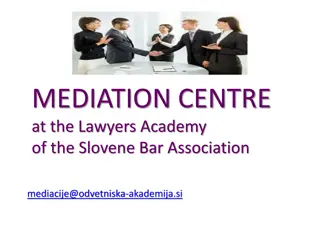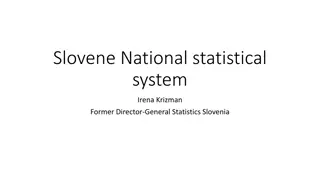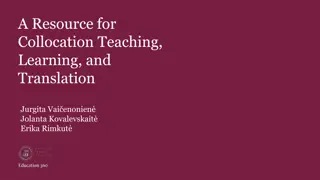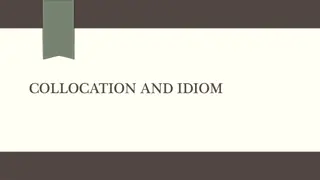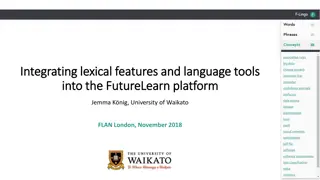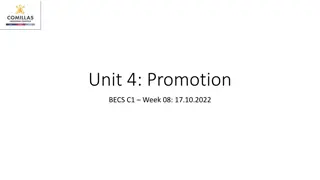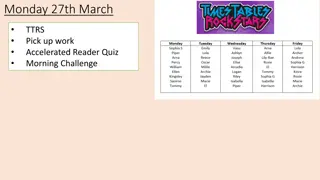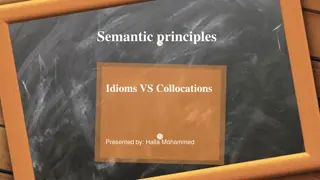Collocations Dictionary of Modern Slovene 2.0
This publication, authored by Iztok Kosem and his team, delves into Slovene collocations, providing valuable insights and resources for language enthusiasts. With contributions from esteemed experts at the University of Ljubljana and Jožef Stefan Institute, this innovative work promises a comprehensive exploration of modern Slovene linguistic patterns.
Download Presentation

Please find below an Image/Link to download the presentation.
The content on the website is provided AS IS for your information and personal use only. It may not be sold, licensed, or shared on other websites without obtaining consent from the author.If you encounter any issues during the download, it is possible that the publisher has removed the file from their server.
You are allowed to download the files provided on this website for personal or commercial use, subject to the condition that they are used lawfully. All files are the property of their respective owners.
The content on the website is provided AS IS for your information and personal use only. It may not be sold, licensed, or shared on other websites without obtaining consent from the author.
E N D
Presentation Transcript
Collocations Dictionary of Modern Slovene 2.0 Iztok Kosem1, 2, pela Arhar Holdt1, Polona Gantar1, Simon Krek1, 2 1 Faculty of Arts, Centre for Language Resources and Technologies, University of Ljubljana 2Jo ef Stefan Institute eLex 2023 conference, Brno, 27. 6. 2023
Collocations Dictionary of Modern Slovene 1.0 Published in 2018 Dictionary contained: 35,989 headwords 7,717,561 collocations 36,736,168 examples Inovative interface: Collocation-oriented Different filtering options User voting enabled Dictionary database available under Creative Commons BY- SA 4.0 licence Automatic methods for the extraction of lexical information (collocations, examples etc.) from Slovenian corpora (Gantar et al. 2016) Using Sketch Grammar (POS- tagged data) + GDEX Sketch Engine API + considerable amount of post- processing
25/06/23 Important developments since 1.0 Two national research projects (Slovenian Research Agency): Collocations as a Basis for Language Description: Semantic and Temporal Perspectives (2017-2020) New Grammar of Standard Slovene: Resources and Methods (2017- 2020) International projects: Estonian Collocations Dictionary (Kallas et al. 2015) Woordcombinaties (Colman and Tiberius 2018) Croatian Web Dictionary Mre nik (Hude ek and Mihaljevi 2020) A trend of consolidating all language resources into one large database Digital Dictionary Database for Slovene Similar efforts in Estonia, Netherlands etc. 2/x
lexical units (olive green) word forms (forest green) syntactic structures (brown) senses (blue) sense frames (violet) sense translations (red) corpus examples (yellow) resource connections (orange) generic features (grey) entity types that reference other entity types via meta-attributes (white)
25/06/23 User studies Pori et al. (2020; 2021), Arhar Holdt (2021), Pori and Kosem (2021), Arhar Holdt et al. (2021) Main findings: Positive attitudes towards automatically extracted collocations (NOTE: users need to be alerted to it; context provided) Links to corpus data are very important Preference of ordering collocations by frequency Mixed opinions on the crowdsourcing feature in the dictionary 4/x
In the year 2021 Annotation layers Lemmatised POS-tagged Parsed JOS tagset Universal Dependencies Named Entities Semantic Role Labels on JOS dependency labels Gigafida 2.0 corpus Published in 2019 1.2 billion words Deduplicated Standard Slovenian Statistical tagger ( 96%) neural networks (Stanza parser)
26/06/23 New methodology of automatically extracting collocations from corpora New grammatical formalism for description of collocations Focused on dependency annotation layer (to a certain extent) replicates the MWEtoolkit (Ramisch et al.) Combining restrictions & representation formalism using corpus annotations on morphological and syntactic levels 82 syntactic structures 6/x
25/06/23 Why a new formalism Typical forms of elements in collocations (representation) finan na te ava finan ne te ave (financial + difficulty financial difficulties) stresti bonbon stresti bonbone (drop + candy drop candies) dobra mo nost bolj e mo nosti (good chance better chances) Better at identifying difficult relations (e.g. subject and object) substanca + absorbirati substance absorbs x absorbirati + substance substance The possibility of including all levels of annotation into the game Extended collocations From patterns (valency, frames + semantic types), to collocations (excluding phraseology or MWEs) (NNominative+ V) (V + NAcusative) x absorbs 7/x
25/06/23 Collocations Dictionary of Modern Slovene 2.0 SOKOL project (2021-2022) upgrading Collocations Dictionary and Thesaurus (funded by the Ministry of Culture) Parameters: 25 collocations for collocationally-productive syntactic structures, 10 for all others Minimum frequency of a collocation = 4 Collocations extracted for nouns (excluding proper nouns), adjectives, adverbs, and verbs 138,032 candidate headwords 81,445 met the criteria (128 compounds) 8/x
26/06/23 Collocations Dictionary of Modern Slovene 2.0 Version 2.0: 81,445 headwords nearly 4.5 million collocations more than 17 million examples 4476 entries with sense division (1608 fully completed) Currently available at https://viri.cjvt.si/kolokacije-beta/ Soon to replace version 1.0 at https://viri.cjvt.si/kolokacije/ 9/x
27/06/23 From 1.0 to 2.0 10/x
25/06/23 Three types of entries (1) Type 1: Completed entry Senses Examined collocations Automatically extracted examples 12/x
25/06/23 Three types of entries 13/x
25/06/23 Three types of entries 14/x
25/06/23 Three types of entries (2) Type 2: Semi-completed entry Senses Examined collocations (*if available) Automatically extracted collocations Automatically extracted examples 15/x
25/06/23 from Thesaurus of Modern Slovene Three types of entries 16/x
25/06/23 from Comprehensive Slovenian- Hungarian dictionary Three types of entries 17/x
25/06/23 Three types of entries (3) Type 3: Automatic entry Automatically extracted collocations Automatically extracted examples 18/x
25/06/23 Three types of entries 19/x
26/06/23 Crowdsourcing feature Various crowdsourcing studies have shown that: Users have difficulties in determining whether a word combination is or is not a collocation Much higher reliability when asked to assign examples of collocations to relevant senses Shift of crowdsourcing option in version 2.0 Determining the suitability (and sense) of examples Indirectly confirming collocation but the final decision is left to lexicographers 20/x
26/06/23 Three types of entries 21/x
26/06/23 Three types of entries 22/x
25/06/23 Plans for the future More regular updates to the dictionary New editor for the Digital Dictionary Database! over half a million of collocation candidates in the most relevant structures to be checked by end of 2023 (CLARIN.SI project) Further improvements of extraction methodology Extended collocations Grouping of collocations by characteristics and/or semantic properties Immediate availability of user votes in the interface 23/x
25 June 2023 Thank you. Iztok Kosem iztok.kosem@ff.uni-lj.si This research was carried out with the support of ARRS (Slovenian Research Agency) through the research programme P6-0411 "Language Resources and Technologies for Slovene , The research programme P6-0215 Slovene Language Basic, Contrastive, and Applied Studies the infrastructure programme I0-0022 "Network of Research Infrastructure Centres (MRIC) at the University of Ljubljana. 24/x
